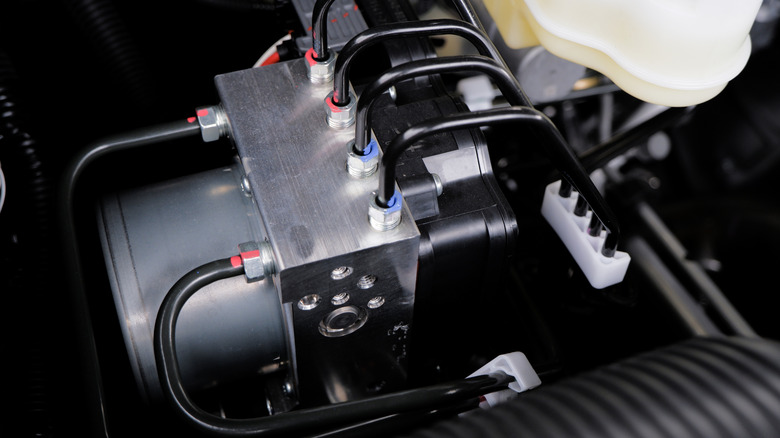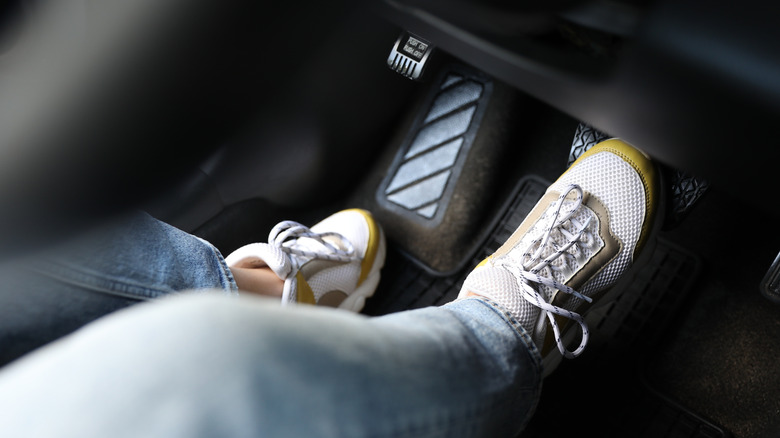What Is A Brake-By-Wire System And What Happens If It Fails While Driving?
Most people may not know it, but in many modern cars, the brakes aren't actually connected the way they used to be. Nowadays, pressing the pedal doesn't always mean you're pushing brake fluid through a brake line anymore, especially if you're driving a hybrid or an EV. You could be just sending a signal. This time round, there's a wire, not a brake line. The pedal's got sensors, which send information — about how hard you pressed the pedal — to a computer, which then tells the brakes what to do. Instead of a hydraulic connection between the pedal and the brakes, it's just software and electronics.
Does it feel different? More often than not, no. A brake-by-wire system still feels like normal brakes, and that's because the pedal is designed to push back a bit so it feels familiar. In reality, though, it's more of an act. It's lighter, it reacts faster, and it works seamlessly with all the new tech that cars use these days like ABS, traction control, emergency braking, and so on. Brake-by-wire lets all these systems work in tandem with the brakes almost instantly, far quicker than traditional fluid setups ever could.
However, this is where things get mushy. When it fails, it fails differently. You won't get the spongy pedal or a slow leak along the lines. It just cuts out, and that's what makes people nervous — understandably. If it does fail, however, every car has backup hydraulic brakes, which will kick in to make sure you can come to a stop or slow down safely.
How brake-by-wire works
When you hit the brake pedal in a brake-by-wire car, it's not going to send fluid flowing down to the calipers. Instead, there are sensors that pick up how hard, how fast, and how far you pressed the pedal. That data is then sent to the ECU, which then decides how much braking force each wheel needs, something Bosch confirms is standard in most of its wire-based systems.
To make the pedal comfortable or at least familiar, manufacturers usually include a motor or spring in the pedal to give you some force feedback. Once the computer gets your input, it sends out signals to either electric actuators, or in some cases an electrohydraulic pump. This unit then applies the brakes to each wheel in a sealed loop, all without the need for any mechanical link. The computer controls each wheel independently, modulating braking force based on speed, grip, load, and stability. It all sounds like new tech, but this invention has been around since 2005, meaning you could be driving a brake-by-wire car without even realizing it.
It gets even better in hybrids and EVs with regenerative braking, which lets the motor itself slows the car down first, before involving the actual brakes. This saves your pads and rotors, especially if seamlessly coordinated with friction braking.
What happens when it fails
When a brake-by-wire system chooses to disappoint, it doesn't give you much warning, and that is the catch. Unlike with traditional hydraulics, there's no sound, no leak, no warning light. Just little to non-existent braking force, which isn't something you'd want when you're approaching city traffic or gliding down a slope. Thankfully, every car has a redundant hydraulic braking system that kicks in if the brake-by-wire system fails.
Volvo just recalled over 1400 Volvo EVs and PHEVs in 2025 due to a problem with the brake control module. The company issued a warning about the possibility of abrupt loss of braking ability, a stark reminder that electronic malfunctions may lead to complete brake failure without warning.
The sensors fail too at times, with several drivers claiming not to get any response after hitting the pedal. The system is not immune to software bugs or power issues, either, and even a short blip in the electronics can shut the whole thing down, but that's not all. Any specific fault with a brake-by-wire system, no matter how small you think it is, has no quick fix. There's no brake fluid to top up or a cable to adjust. Everything is hidden in code, and in the event this code fails, the only option is to involve the pros or the dealership.


